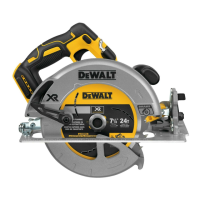dealer.
Kickback
Kickback is a sudden reaction to a pinched, bound or misaligned
saw blade, causing an uncontrolled saw to lift up and out of the
workpiece toward the operator. When the blade is pinched or
bound tightly by the kerf closing down, the blade stalls and the
motor reaction drives the unit rapidly back toward the operator.
If the blade becomes twisted or misaligned in the cut, the teeth
at the back edge of the blade can dig into the top surface of the
wood causing the blade to climb out of the kerf and jump back
toward theoperator.
Kickback is more likely to occur when any of the following
conditionsexists.
1. IMPROPER WORKPIECE SUPPORT
a. Sagging or improper lifting of the cut off piece can cause
pinching of the blade and lead tokickback.
b. Cutting through material supported at the outer ends
only can cause kickback. As the material weakens it sags,
closing down the kerf and pinching the blade (Fig.L).
c. Cutting off a cantilevered or overhanging piece of
material from the bottom up in a vertical direction
can cause kickback. The falling cut off piece can pinch
theblade.
d. Cutting off long narrow strips (as in ripping) can cause
kickback. The cut off strip can sag or twist closing the kerf
and pinching theblade.
e. Snagging the lower guard on a surface below the
material being cut momentarily reduces operator control.
The saw can lift partially out of the cut increasing the
chance of bladetwist.
2. IMPROPER DEPTH OF CUT SETTING ON SAW
a. To make the most efficient cut, the blade should
protrude only far enough to expose one-half of a
tooth as shown in FigureF. This allows the base plate
to support the blade and minimizes twisting and
pinching in the material. See the section titled Cutting
DepthAdjustment.
3. BLADE TWISTING (MISALIGNMENT IN CUT)
a. Pushing harder to cut through a knot, a nail or a hard
grain area can cause the blade totwist.
b. Trying to turn the saw in the cut (trying to get back on
the marked line) can cause bladetwist.
c. Overreaching or operating the saw with poor body
control (out of balance), can result in twisting theblade.
d. Changing hand grip or body position while cutting can
result in bladetwist.
e. Backing up the saw to clear blade can lead totwist.
4. MATERIALS THAT REQUIRE EXTRA ATTENTION
a. Wet timber
b. Green timber (material freshly cut or not kiln dried)
c. Pressure treated timber (material treated with
preservatives or anti-rot chemicals)
5. USE OF DULL OR DIRTY BLADES
a. Dull blades cause increased loading of the saw. To
compensate, an operator will usually push harder which
further loads the unit and promotes twisting of the blade
in the kerf. Worn blades may also have insufficient body
clearance which increases the chance of binding and
increasedloading.
6. LIFTING THE SAW WHEN MAKING A BEVEL CUT
a. Bevel cuts require special operator attention to proper
cutting techniques – especially guidance of the saw. Both
blade angle to the base plate and greater blade surface
in the material increase the chance for binding and
misalignment (twist) tooccur.
7. RESTARTING A CUT WITH THE BLADE TEETH JAMMED
AGAINST THE MATERIAL
a. The saw should be brought up to full operating speed
before starting a cut or restarting a cut after the unit has
been stopped with the blade in the kerf. Failure to do so
can cause stalling andkickback.
Any other conditions which could result in pinching, binding,
twisting, or misalignment of the blade could cause kickback.
Refer to the sections Additional Specific Safety Rules for
Circular Saws and Blades for procedures and techniques that
will minimize the occurrence ofkickback.
Depth of Cut Adjustment (Fig. E–F)
1. Raise the depth adjustment lever
4
toloosen.
2. To obtain the correct depth of cut, align the appropriate
mark on the depth adjustment strap
20
with notch
19
on
the upper bladeguard.
3. Tighten the depth adjustmentlever.
4. For the most efficient cutting action using a carbide tipped
saw blade, set the depth adjustment so that about one half
of a tooth projects below the surface of the wood to becut.
5. A method of checking for the correct cutting depth is
shown in FigureF. Lay a piece of the material you plan to
cut along the side of the blade, as shown in the figure, and
observe how much tooth projects beyond thematerial.
Adjusting Depth Adjustment Lever (Fig. E)
It may be desirable to adjust the depth adjustment lever
4
. It
may loosen in time and hit the base plate beforetighten ing.
To Tighten the Lever:
1. Hold depth adjustment lever
4
and loosen the locknut
18
.
2. Adjust the depth adjustment lever by rotating it in the
desired direction about 1/8 of arevolution.
3. Retightennut.

